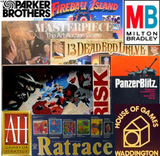HISTORY
Based in Minneapolis, the SLASH Corporation was a game company which repackaged and resold classic 1980s PC titles from such companies as Sierra On-Line, LucasArts Entertainment, Electronic Arts, The Software Toolworks, and others. Its President (founder?) was Charles F. Bond, and it existed as an independent company from 1991 to 1995. In June of 1996, GT Interactive Software Corp purchased SLASH, and reintroduced it as part of their Value Products Division. Mr. Bond was given a seat on the board of directors and the title of Vice-President, SLASH Division.

HOW TO TELL THE DIFFERENCE
So how can a collector of classic games distinguish between an original PC game and a re-published SLASH version? Well, this guide would be fairly pointless f it couldn’t answer this question, wouldn’t it! In fact, there are FIVE (5) distinguishing features of a SLASH product. (Note: not all characteristics will be common to every game; some will have one or two features from this list, some more, some all.)
- The Box
- The Label
- The Box Cover Art
- The Diskettes
- Manuals & Other Documentation
1. The Box: SLASH re-releases come in cheap, white, one-piece cardboard boxes with flapped openings on either end. Original releases are usually come in higher grade cardboard boxes, often with the company logo affixed in some way upon them.
2. The Label: Most system requirements labels for older games were affixed onto the box or slipcover casing AFTER it had been manufactured. This permitted companies to use the same box for different platforms (such as MS-DOS, Apple II or Macintosh). SLASH re-releases have their labels as part of the box itself. Further, SLASH re-releases often use black lettering on white labels, whereas original releases will have color within the label or graphic images (such as the company logo). For those SLASH re-releases that use the original system requirements box on the cover, and not the white background/black print, the lettering is difficult to read. The reason is:
3. The Cover Art: Original releases often have crisp, breathtaking covers. Due to the inferior quality of computer graphics of the day, covers were not of game images, but of conceptual art. A SLASH re-release uses those same covers, but since they are reprints of scanned images, the quality is somewhat poor. SLASH covers seem out-of-focus, fuzzy and difficult to read the printing. Often, the black print/white label stands in stark contrast to the cover image, appearing to have been placed over the original release cover, scanned in, and then reprinted.
4. The Diskettes: The 3.5″ and/or 5.25″ disks found in original PC game releases usually have color labels, company logos or graphic art. SLASH re-releases use plain black lettering on a white label.
5. Manuals & Other Documentation: SLASH re-releases use photocopies of the original game documents, printed in monochrome on cheap paper, clearly in an effort to keep the cost of their reproduction as low as possible. No special brochures, high-quality glossy covers, or any other extras that the original PC game releases used!
One last thought: if your goal is to play one of these classic games, a SLASH re-release is one of the least expensive methods of acquiring a physical copy of it. Don’t forget that your new computer may not be able to play those ancient games, though!
Filed under: PC Games, Retro Gaming | Tagged: PC Games, pc gaming, reproduction, retrogaming, SLASH |










Leave a comment